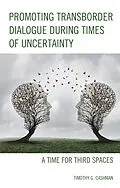Promoting Border Dialogue During Times of Uncertainty: A Time for Third Spaces is the product of years of investigations and publications focusing on the importance of dialogic processes in the fields of education, cultural work, economics, and politics. Recent, pivotal events reinforce the need for reimagining, reconceptualizing, redesigning, and reconstructing educational and governmental institutions. Hope for the amelioration of racial-, ethnic-, class-, religion- and gender-based conflicts resides in the implementation of effective dialogue. Dialogue must cross borders, internally and externally. Border crossings, not limited to geographic or political, are requisite for understandings of the current local, regional, national, transnational, and global conditions. Recent events make necessary a critical border praxis, which includes the creation of third spaces. Current conditions in the US and worldwide add to the urgency of addressing and responding to existential issues confronting educational institutions, societies, economies, and governments at all levels.
Autorentext
Timothy G. Cashman is professor in the department of teacher education at the University of Texas at El Paso.
Inhalt
Chapter 1: Introduction
Chapter 2: Border Pedagogy Revisited
Chapter 3: An Examination of Place-Based Pedagogies
Chapter 4: Transborder Dialogue: Intersections of Meliorism, Heteroglossia, Nepantla, and Dialogic Feminism
Chapter 5: Transnational Possibilities: The Importance of Critical Cosmopolitanism and Pragmatic Hope
Chapter 6: Navigating the Intersection of Border Pedagogy and Critical Place-Based Pedagogies
Chapter 7: Critical Border Praxis: Choosing the Path
Chapter 8: Transnational Educational Research in Four Countries: Examples of Critical Border Praxis
Chapter 9: In Spite of the Way the World Is: What United States Educators Can Learn from Their Counterparts in Cuba
Chapter 10: They Did Not Make Their Decisions on a Whim: Teaching Border Issues on the United States and Mexico
Chapter 11: In Pursuit of Comparative Pedagogies
Chapter 12: Emergent Third Spaces
Chapter 13: Conclusion: There Has Never Been a More Crucial Time
